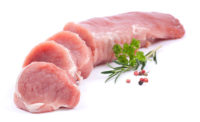The COVID-19 pandemic has brought its own set of challenges to whole-muscle processing. Whole-muscle cuts, many of which are higher in value, have become a challenge for manufacturers to figure out how to distribute those to a growing population of consumers that are in a bit of a crisis mode, says Jeff Sindelar, associate professor and extension meat specialist in the Animal Sciences College of Agricultural and Life Sciences at the University of Wisconsin in Madison. Additionally, most consumers don’t have the same disposable income as before COVID-19, and ground beef generally has become in greater demand than more expensive whole-muscle cuts, he says.
Consumers also are buying in different patterns than they did before the pandemic, and certain whole-muscle products are seeing an uptick in demand, says Jacob Nelson, facilities manager and meat processing specialist at Oklahoma State University’s Robert M. Kerr Food and Agricultural Products Center in Stillwater. Manufacturers are diverting whole-muscle products that might have otherwise been headed to the foodservice sector and tailoring the products for retail. Across the industry, COVID-19 has added to the challenge of finding enough employees for daily production.
Consistent quality
When processing whole-muscle products under normal conditions, one of the greatest challenges remains starting with a quality protein.
“Most of the products, you get what you get,” Sindelar says. For example, if the processor has variation in raw-material quality — color, water-holding capacity, fat, connective tissue or structure, etc. — consumers and retailers will notice.
“Having uniform, high-quality raw materials or the right level of quality for the raw materials that you need for the product and process to be successful is usually much more important for whole-muscle than ground or formed products,” Sindelar says. “With grinding and forming, you take all those variations and make it uniform again, and this also allows you the ability to not hide, but mask, some of those things that would become an issue in a whole-muscle product.”
For example, if a processor is dealing with a large amount of connective tissue, the processor can manipulate the connective tissue into smaller pieces by grinding.

Processors largely have addressed raw-material challenges by working with their suppliers and identifying which suppliers are producing the raw materials they need then balancing cost, availability, volume and other demands, Sindelar explains.
Larger carcass sizes still remain somewhat of an issue, depending on the meat or poultry cut, but the industry has adapted, Sindelar says. For example, if a processor is making a roast beef using muscles from the round, the processor is able to trim those down or cut them in half. A greater challenge might be for manufacturers of bone-in ham. As pork subprimals get heavier, cuts get heavier. In turn, if manufacturers of bone-in ham or pork bellies are looking from a certain weight range, they might have less availability on the lighter side. The turkey’s case, a breast can only get so large and then it becomes hard to market to consumers.
Nelson agrees the industry has evolved to address larger portion sizes, especially with beef. Consumers and purveyors want to hit a particular portion target or thickness. The National Cattlemen’s Beef Association’s alternative cut merchandising program has helped to sell at retail some cuts that have come from larger carcasses. The industry also has addressed weight extremes by discounting the purchase price.
Whole-muscle processors also are embracing technology to address raw-material challenges such as uniformity and adjusting products and processes accordingly, Sindelar says. Whole-muscle processors also have a better understanding of how quality raw materials affect downstream processes as well as finished product. As a result, the availability of technologies such as injection equipment that is highly adjustable is being more widely used by processors. For example, processors now are able to minimize injection variation because of muscle-quality differences throughout a particular cut, Sindelar explains.
Nelson agrees the industry continues to attempt to make whole-muscle products more consistent. In turn, pork and poultry processors also have been applying more automation for slaughter and fabrication. While automation removes a lot of variation, it also comes at a cost to yield, he adds.
Another accomplishment that Nelson believes the industry should be proud of is its advancement in whole-muscle food safety. With hazard analysis and critical control points (HACCP) and Global Food Safety Initiative (GFSI) programs and customer-driven safety, the industry is experiencing a very positive food-safety record, he says.
Nelson does anticipate changes to food-safety programs will occur to address COVID-19 concerns in regard to package handling. “Whether it’s whole muscle or ground, there will be changes in how processors police themselves and the handling of product because now we’re talking person-to-person transmissions,” he says. “If I touch a package, then you touch a package, people are going to start asking, ‘How dirty is this package?’”
Whole-muscle innovation

For the past 20 years, an explosion of different cuts and flavors representing different cultures and regions of the country and world has emerged in whole-muscle products.
Recently, whole-muscle protein cuts have been doing more innovation around home-style cuts, such as offering cuts that might have been at a grandparent’s house for Sunday dinner. A market for whole-muscle products as part of a larger snack item, such as protein packs, also is trending, says Jacob Nelson, facilities manager and meat processing specialist at Oklahoma State University’s Robert M. Kerr Food and Agricultural Products Center in Stillwater.
Whole-muscle processors also are using different packaging strategies. For example, processors are using more ways to take a whole-muscle cut and make it more attractive for a party of two or for a single person rather than a whole-muscle product for a picnic or family gathering.
“Processors are continuing to look at how to make old look new again and doing it in a way that is attractive to today’s consumers if that means maybe less focus on being price conscious, but more convenience and value for the price and variety,” says Jeff Sindelar, associate professor and extension meat specialist in the Animal Sciences College of Agricultural and Life Sciences at the University of Wisconsin in Madison. NP





Report Abusive Comment